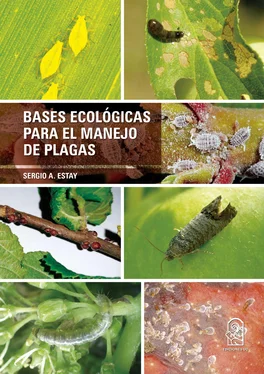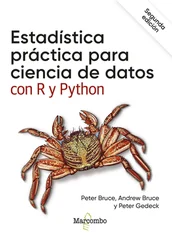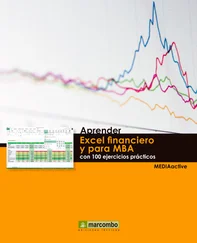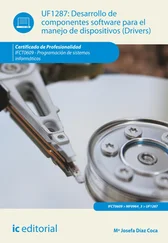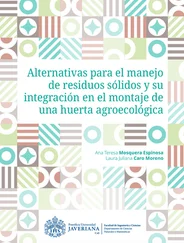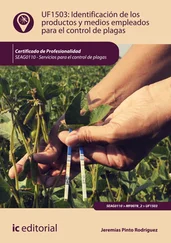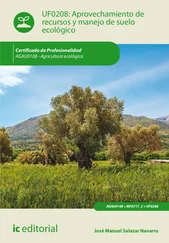Fuentes-Contreras, E., Basoalto, E., Franck, P., Lavandero, B., Knight, A. L. y Ramírez, C. C. (2014). Measuring local genetic variability in populations of codling moth (Lepidoptera: Tortricidae) across an unmanaged and commercial orchard interface. Environmental Entomology, 43, 520-527.
Groeters, F. R. y Tabashnik, B. E. (2000). Roles of selection intensity, major genes, and minor genes in the evolution of insecticide resistance. Journal of Economic Entomology, 93, 1580-1587.
Hemingway, J. (2000). The molecular basis of two contrasting metabolic mechanisms of insecticide resistance. Insect Biochemistry and Molecular Biology, 30, 1009-1015.
Homem, R. A. y Davies, T. G. (2018). An overview of functional genomic tools in deciphering insecticide resistance. Current Opinion in Insect Science, 27, 103-110.
Homem, R. A., Buttery, B., Richardson, E., Tan, Y., Field, L. M., Williamson, M. S. y Emyr Davies, T. G. (2020). Evolutionary trade-offs of insecticide resistance. The fitness costs associated with target-site mutations in the nAChR of Drosophila melanogaster. Molecular Ecology , 2, 2661-2675.
Hoy, M. A. (1998). Myths, models and mitigation of resistance to pesticides. Philosophical Transactions of the Royal Society of London . Series Biology, 353 , 1787-1795.
Kikuchi,Y., Hayatsu, M., Hosokawa, T., Nagayama, A., Tago, K. y Fukatsu, T. (2012). Symbiontmediated insecticide resistance. Proceedings of the National Academy of Science U.S.A., 109, 8618-8622.
Kliot, A. y Ghanim, M. (2012). Fitness costs associated with insecticide resistance. Pest Management Science, 68, 1431-1437.
Li, X., Schuler, M. A. y Berenbaum, M. R. (2007). Molecular mechanisms of metabolic resistance to synthetic and natural xenobiotics. Annual Review of Entomology, 52, 231-253.
Liu, X. D. y Guo, H. F. (2019). Importance of endosymbionts Wolbachia and Rickettsia in insect resistance development. Current Opinion in Insect Science , 33, 84-90.
McKenzie, J. A. (2001). Pesticide resistance. En C. W. Fox, D. A. Roff, y D. J. Fairbairn (Eds.), Evolutionary ecology: concepts and case studies (pp. 347-360). Oxford: Oxford University Press.
Melander, A. L. (1914). Can insects become resistant to sprays? Journal of Economic Entomology, 7, 167-173.
Mota-Sánchez, D., Bills, P. S. y Whalon, M. E. (2002). Arthropod resistance to pesticides: status and overview. En W. B. Wheeler (Ed.), Pesticides in agriculture and the environment (pp. 241-273). New York: Marcel Dekker Inc.
Mota-Sánchez, D., Whalon, M. E., Hollingworth, R. M. y Xue, Q. (2008). Documentation of pesticide resistance in arthropods. En M. E. Whalon, D. Mota-Sánchez y R. M. Hollingworth (Eds.), Global pesticide resistance in arthropods (pp. 32-39). Wallingford: CABI.
Oakeshott, J. G., Home, I., Sutherland, T. D. y Russell, R. J. (2003). The genomics of insecticide resistance. Genome Biology, 4, 202.
Onstad, D. W. (2008). Major issues in insect resistance management. En D. W. Onstad (Ed.), Insect resistance management: biology, economics and prediction (pp. 1-16). London: Academic Press.
Onstad, D. W. y Guse, C. A. (2008). Concepts and complexities of population genetics. In D. W. Onstad (Ed.), Insect resistance management: biology, economics and prediction (pp. 69-88). London: Academic Press.
Oppold, A. M. y Müller, R. (2017). Epigenetics: a hidden target of insecticides. Advances in Insect Physiology, 53, 313-324.
Pietri, J. E. y Liang, D. (2018). The links between insect symbionts and insecticide resistance: causal relationships and physiological tradeoffs. Annals of the Entomological Society of America, 111, 92-97.
Pittendrigh, B. R., Margan, V. M., Sun, L. y Huesing, J. E. (2008). Resistance in the post-genomics age. En D.W. Onstad (Ed.), Insect resistance management: biology, economics and prediction (pp. 39-68). London: Academic Press.
Reyes, M., Bouvier, J., Boivin, T., Muñoz, C., Fuentes-Contreras, E. y Sauphanor, B. (2004). Susceptibilidad a insecticidas y actividad enzimática de Cydia pomonella L. (Lepidoptera: Tortricidae) provenientes de tres huertos de manzano de la Región del Maule, Chile. Agricultura Técnica (Chile), 64, 229-237.
Reyes, M., Franck, P., Olivares, J., Margaritopoulos. J., Knight, A. y Sauphanor, B. (2009). Worldwide variability of insecticide resistance mechanisms in the codling moth, Cydia pomonella L. (Lepidoptera: Tortricidae). Bulletin of Entomological Research, 99, 359-369.
Reyes, M., Barros-Parada, W., Ramírez, C. C. y Fuentes-Contreras, E. (2015). Organophosphate resistance and its main mechanism in populations of Cydia pomonella (Lepidoptera: Tortricidae) from central Chile. Journal of Economic Entomology, 108, 277-285.
Roush, R. T. y McKenzie, J. A. (1987). Ecological genetics of insecticide and acaricide resistance. Annual Review of Entomology, 32, 361-380.
Roush, R. T. y Daly, J. C. (1990). The role of population genetics in resistance research and management. En R. T. Roush y B. E. Tabashnik (Eds.), Pesticide resistance in arthropods (pp. 97-152). New York: Chapman and Hall.
Rubiano-Rodríguez, J. A., Fuentes-Contreras, E., Figueroa, C. C., Margaritopoulos, J. T., Briones, L. M. y Ramírez, C. C. (2014). Genetic diversity and insecticide resistance during the growing season in the green peach aphid (Hemiptera: Aphididae) on primary and secondary hosts: a farm-scale study in central Chile. Bulletin of Entomological Research, 104, 182-194.
Rubiano-Rodríguez, J. A., Fuentes-Contreras, E. y Ramírez, C. C. (2019). Neutral genetic variability and resistance mechanisms present in Myzus persicae (Hemiptera: Aphididae) from different hosts in central Chile. Ciencia y Tecnología Agropecuaria , 20, 611-633.
Rubio-Meléndez, M. E., Sepúlveda, D. A. y Ramírez, C. C. (2018). Temporal and spatial distribution of insecticide resistance mutations in the green peach aphid Myzus persicae (Hemiptera: Aphididae) on primary and secondary host plants in central Chile. Pest Management Science, 74, 340-347.
Russell, R. J., Claudianos, C., Campbell, P. M., Horne, I., Sutherland, T. D. y Oakeshott, J. G. (2004). Two major classes of target site insensitivity mutations confer resistance to organophosphate and carbamate insecticides. Pesticide Biochemistry and Physiology, 79, 84-93.
Samantsidis, G. R., Panteleri, R., Denecke, S., Kounadi, S., Christou, I., Nauen, R., Douris, V. y Vontas, J. (2020). ‘What I cannot create, I do not understand’: functionally validated synergism of metabolic and target site insecticide resistance: synergism of resistance mechanisms. Proceedings of the Royal Society B: Biological Sciences , 287, 20200838.
Sawicki, R. (1987). Definition, detection and documentation of insecticide resistance. En M.G. Ford, D.W. Holloman, B. P. Khambay y R. M. Sawicki (Eds.), Combating resistance to xenobiotics: biological and chemical approaches (pp. 105-117). London: Ellis Horwood.
Scott, J. G. (1999). Cytochromes P450 and insecticide resistance. Insect Biochemistry and Molecular Biology, 29, 757-777.
Silva, A. X., Samaniego, H., Ramsey, J. y Figueroa, C. C. (2012a). Insecticide resistance mechanisms in the green peach aphid Myzus persicae (Hemiptera: Aphididae) I: a transcriptomic survey. PLOS ONE , 7(6),e3636.
Silva, A. X., Bacigalupe, L. D., Luna-Rudloff, M. y Figueroa, C. C. (2012b). Insecticide resistance mechanisms in the green peach aphid Myzus persicae (Hemiptera: Aphididae) II: costs and benefits. PLOS ONE, 7(6):e36810.
Silva, G. (2003). Resistencia a los insecticidas. En G. Silva y R. Hepp (Eds.), Bases para el manejo racional de insecticidas (pp. 237-259). Chillán: Universidad de Concepción/ Fundación para la Innovación Agraria.
Читать дальше
